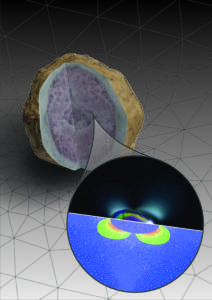 Check our our latest paper on Finite Element modelling of stresses in inclusions by Mattia L. Mazzucchelli on Geology. Elastic geothermobarometry on inclusions is a method to determine pressure-temperature conditions of mineral growth independent of chemical equilibrium. Because of the difference in their elastic properties, an inclusion completely entrapped inside a host mineral will develop a residual stress upon exhumation, from which one can back-calculate the entrapment pressure. Current elastic geobarometric models assume that both host and inclusion are elastically isotropic and have an ideal geometry (the inclusion is spherical and isolated at the center of an infinite host). These conditions do not commonly occur in natural rocks, and the consequences for inclusion pressures can only be quantified with numerical approaches. In this paper, we report the results of numerical simulations of inclusions with the finite element method on elastically isotropic systems. We define and determine a geometrical factor (Γ) that allows measured residual pressures to be corrected for the effects of non-ideal geometry. We provide simple guidelines as to which geometries can safely be used for elastic geobarometry without correcting for the geometry. We also show that the discrepancies between elastic and conventional geobarometry reported in literature are not due to geometrical effects, and therefore result from other factors not yet included in current models.
Check our our latest paper on Finite Element modelling of stresses in inclusions by Mattia L. Mazzucchelli on Geology. Elastic geothermobarometry on inclusions is a method to determine pressure-temperature conditions of mineral growth independent of chemical equilibrium. Because of the difference in their elastic properties, an inclusion completely entrapped inside a host mineral will develop a residual stress upon exhumation, from which one can back-calculate the entrapment pressure. Current elastic geobarometric models assume that both host and inclusion are elastically isotropic and have an ideal geometry (the inclusion is spherical and isolated at the center of an infinite host). These conditions do not commonly occur in natural rocks, and the consequences for inclusion pressures can only be quantified with numerical approaches. In this paper, we report the results of numerical simulations of inclusions with the finite element method on elastically isotropic systems. We define and determine a geometrical factor (Γ) that allows measured residual pressures to be corrected for the effects of non-ideal geometry. We provide simple guidelines as to which geometries can safely be used for elastic geobarometry without correcting for the geometry. We also show that the discrepancies between elastic and conventional geobarometry reported in literature are not due to geometrical effects, and therefore result from other factors not yet included in current models.
Close
© 2018, Experimental Mineralogy Lab, Department of Earth and Environmental Science, Università degli studi di Pavia, Via Adolfo Ferrata, 7, 27100, Pavia (PV), Italy
